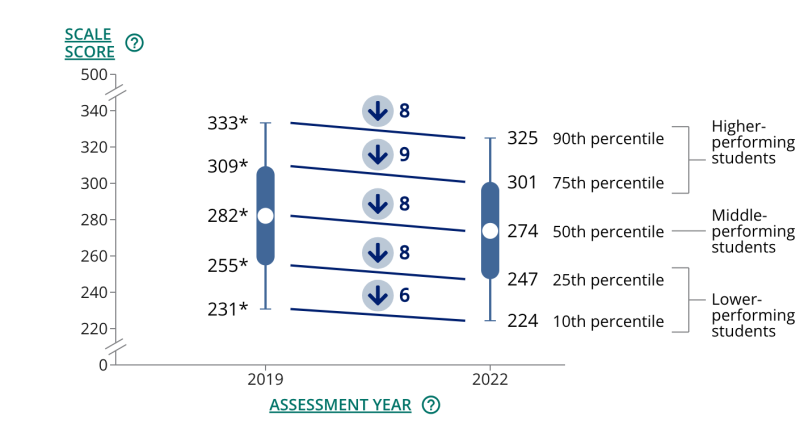How COVID-19 narrowed the STEM pipeline

We don’t have data for other private schools because they have refused to participate in NAEP testing, but the eighth grade math declines among both high-achieving public school and Catholic school students are not good signs.
NAEP tests reading and math in both fourth and eighth grades every two years in order to track educational progress. It’s one of the only tests that can be used for comparisons across states and generations. More than 400,000 students are specially selected to represent the regions and demographic characteristics of the nation.
Among the four NAEP tests, eighth grade math showed the sharpest pandemic drop. Math took a bigger hit than reading because kids can still read at home, while math is something that students primarily learn at school. If you didn’t read “The Hobbit” in your seventh grade English class because you were out sick with Covid, you can still be a good lifelong reader But not getting enough practice with rates, ratios and percentages in middle school can derail someone who might have otherwise excelled.
Why eighth grade math was hit harder than fourth grade math is a bit less obvious. One explanation is that the concepts that students need to learn are more difficult. Square roots and exponents are possibly more challenging to master than multiplication and division. And fewer parents are able to assist with homework as the math increases in complexity.
Yet another explanation is a psychological one. These eighth graders were in sixth grade when the pandemic erupted in the spring of 2020. This is a critical time in adolescent development when children are figuring out who they are and where they belong. A lot of this development occurs through social interaction. The isolation may have stunted psychological development and that ultimately affected motivation, study skills and the ability to delay gratification – all necessary to excel in math.
Let’s walk through the numbers together.
Highest achieving students lost ground in eighth grade math

This chart shows that the highest performing students, those at the top 10% and the top 25%, lost as much as low-achieving students at the bottom in eighth grade math. These eighth graders were in the spring of sixth grade when the pandemic hit in 2020, and it’s possible that they didn’t master important prerequisite skills, such as rates and ratios. These kids at the top are performing at grade level, but not as high performing as past eighth graders.
Fewer eighth grade students hit advanced and proficient levels

This bar chart shows that before the pandemic 10% of the nation’s eighth graders were performing at an advanced level in math. That fell to 7%. And the number of students deemed proficient in eighth grade math fell even more, from 24% to 20%. Before the pandemic, arguably, 34% of the eighth grade population was on track to pursue advanced math in high school and a future STEM career if they wanted one. After the pandemic in 2022, only 27% were well prepared.
Students at Catholic schools are generally much higher performing than students at public schools. In large part, that’s because of family income; wealthier students tend to have higher test scores than poorer students. Catholic school students tend to be wealthier; their families can afford private school tuition. In recent years, the Catholic Church has closed hundreds of schools that catered to low-income families, leaving a higher income population in its remaining classrooms.
Catholic schools outperformed public schools but also dropped

This chart shows that Catholic school students, depicted by the diamonds, outperformed public school students, depicted by the circles, in eighth grade math. But it was still a sharp five-point decline in eighth grade math performance for Catholic school students, almost as large as the eight-point decline for public school students. Scores of white students at Catholic schools declined five points; scores of students at Catholic schools in the suburbs declined seven points. Almost a quarter of Catholic school students are now functioning below a basic level in math for their grade.
Despite the good academic reputation of Catholic schools and the praise Catholic schools received for resuming in-person instruction sooner, math scores suggest a problem. And it’s a problem that potentially extends to the whole private school universe, where 9% of students are enrolled, according to the most recently available data from 2019.
I talked with Ron Reynolds, the executive director of the California Association of Private School Organizations, who explained that not just Catholic schools, but also many other private schools suffered even if they hadn’t been closed for long. Reynolds said that private schools were still hit by illnesses, deaths and absences and that might have affected instruction.
“Private schools are tightly knit communities in which teachers tend to be more intertwined in the lives of the children and families they serve,” he said. “When you have a crisis, and so many people experiencing stress and loss, that can certainly impact the teacher in some significant ways.”
Unfortunately, we don’t know exactly how other private schools fared during the pandemic because they have refused to participate in the NAEP tests for the past decade. Reynolds, who serves on the governing board that oversees the NAEP exam, has been trying to lobby more private schools to participate, but so far, to no avail.
Together private schools, selective public schools and affluent suburban schools have been important training grounds for the nation’s future scientists and engineers. Of course, it is possible that these high achieving students, now 10th graders, will catch up. Many of them are from wealthier families who can afford tutors, or attend well-resourced schools. But I am not seeing much evidence that schools have had the ability to think about the pipeline of advanced students when many students are so needy. And with post-pandemic grade inflation, students and parents may not be getting the signals they need to seek extra help independently.
The administration of the 2024 NAEP test wrapped up in March, but results won’t be known for many months. I’ll be keeping an eye on eighth grade math and on SAT, ACT and Advanced Placement scores in the years to come.



